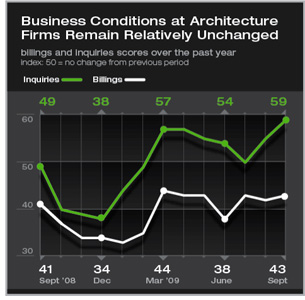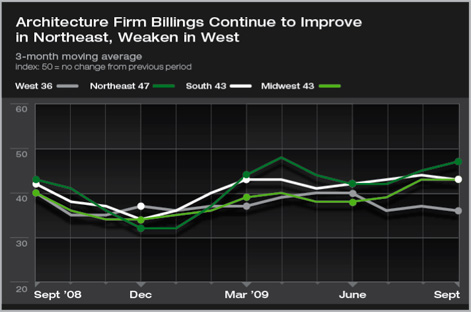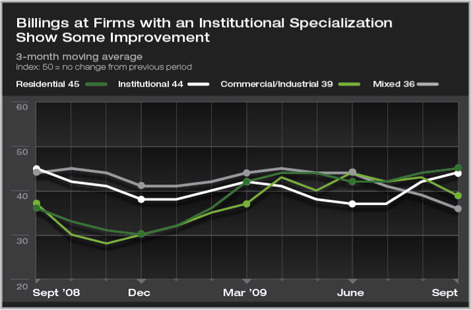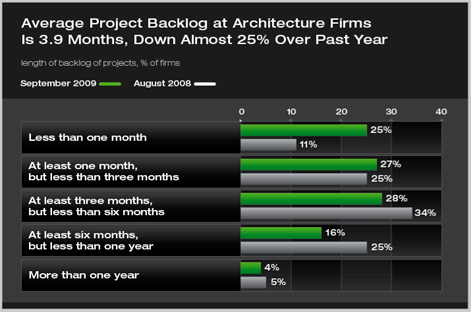work-on-the-boards
Architecture Firm Billings Remain Relatively Weak
Project Backlogs at Firms Shrink to 3.9
Months
by Jennifer Riskus
AIA Economics Research Manager
 Summary: Despite
recording the highest inquiries score in two years, the Architecture
Billings Index remains mired in the low 40s, with a score of 43.1
reported in September. Architecture firm billings have been in this
vicinity for six of the last seven months, and have not yet shown
any clear signs of approaching 50, and an increase in billings. Business
conditions remain quite poor for many firms, with increasing numbers
indicating nonexistent project backlogs and insufficient billable
hours for current staff. Inquiries scores are still rising, but this
continues to be triggered by the increased competition for projects,
rather than actual increases in project activity. Summary: Despite
recording the highest inquiries score in two years, the Architecture
Billings Index remains mired in the low 40s, with a score of 43.1
reported in September. Architecture firm billings have been in this
vicinity for six of the last seven months, and have not yet shown
any clear signs of approaching 50, and an increase in billings. Business
conditions remain quite poor for many firms, with increasing numbers
indicating nonexistent project backlogs and insufficient billable
hours for current staff. Inquiries scores are still rising, but this
continues to be triggered by the increased competition for projects,
rather than actual increases in project activity.
Business conditions remain weak in all regions of the country, with
firms in the West reporting the slowest conditions for the third
month in a row. While a higher share of firms in the Northeast are
reporting improving billings than they did several months ago, the
score remains below 50, indicating that firms with declining billings
still outweigh those reporting improving billings.

By sector, firms with a commercial/industrial and institutional
specialization continue to report the weakest business conditions.
Firms with a residential specialization reported their highest score
in more than two and a half years in September, as the demand for
housing finally seems to be rebounding.

Despite the fact that payroll employment continues to decline (263,000
jobs were lost in September alone), the pace of the losses is much
slower than it was earlier this year and at the end of 2008, when
nearly three times that many jobs were being shed each month. However,
architecture firm employment continues to decline as a part of this
contraction, and fell to 188,300 in August (the most recent data
available). This is down 16 percent from the most recent peak of
224,500 in July 2008. However, in line with the fact that many believe
the recession has already ended, the Reuters/University of Michigan
Index of Consumer Sentiment rebounded to 73.5 in September, the highest
level it has reached since early 2008. But the nascent recovery continues
to be hampered by weak consumer finances and rising unemployment,
a trend that is not expected to reverse until sometime next year.
As the economy has faltered, so too has the backlog of projects
at architecture firms declined in the last year. Project backlog,
the amount of work in house and under contract, has fallen from 5.1
months in August 2008 to just 3.9 months in September 2009. More
than half of survey respondents (52 percent) report backlogs of less
than three months with just one-fifth reporting backlogs of six months
or longer. Large firms, with more than $5 million in annual billings,
report the longest current backlogs, 5.7 months, compared to just
over three months for firms with annual billings of less than $1
million. Firms with an institutional specialization also report more
substantial backlogs; at 5.7 months they are averaging double those
found at firms with a residential or commercial/industrial specialization.

In addition, two-thirds of respondents indicated that backlogs at
their firm are lower now than they were at the beginning of the year;
15 percent report that they have been relatively unchanged during
that time while, 18 percent indicate that backlogs are higher now.
However, many firms indicated anecdotally that they have very low
confidence in their current backlogs, and that they could change
at any time, due to the lack of available credit, and projects not
advancing beyond the design phase, among other reasons. |





